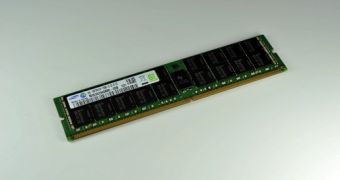Memory expert manufacturer, Korean giant company Samsung has just announced that it is already sampling DDR4 server modules with high densities of up to 16 GB. The module announced today is a RDIMM 16 GB DDR4 server memory.
Samsung has been on the forefront of the DDR4 development since December 2010 when it first showed industry's first 30nm-class 2 GB DDR4 module.
Today’s 16 GB hero is also built in 30nm manufacturing technology, but Samsung has pledged that it would start manufacturing memory chips in 20nm technology starting next year.
Once the 20nm production line starts making DDR4 memories, densities will reach an amazing 32 GB per module.
One of the advantages DDR4 memory brings overall is the fact that it works using a modest 1.2V voltage and compared with DDR3’s standard voltage of 1.35V, it will consume up to 40 percent less energy.
The company has already sampled new 8 GB and 16 GB DDR4 modules in June and then sent them over to CPU and controller makers for testing and development.
DDR4 will double the performance achieved by today’s DDR3 memory standard, as it will double the 1600 MBits/s data rate of the DDR3 memory modules.
Samsung is the first company to ever introduce DDR memory back in 1997.
RDIMMs, or Registered DIMMs are server grade memory modules. They costume just a bit more energy than normal or UDIMM modules because they contain additional circuitry and components needed for a register.
Registered Dual Inline Memory Modules are needed for applications requiring stability and scalability as, by using RDIMMs, some motherboards can support higher memory densities and an overall higher amount of RAM.
RDIMMs can be ECC or nonECC, as there are both, Registered ECC memory and non-Registered ECC memory, as well as just Registered or Unregistered memory.

 14 DAY TRIAL //
14 DAY TRIAL //